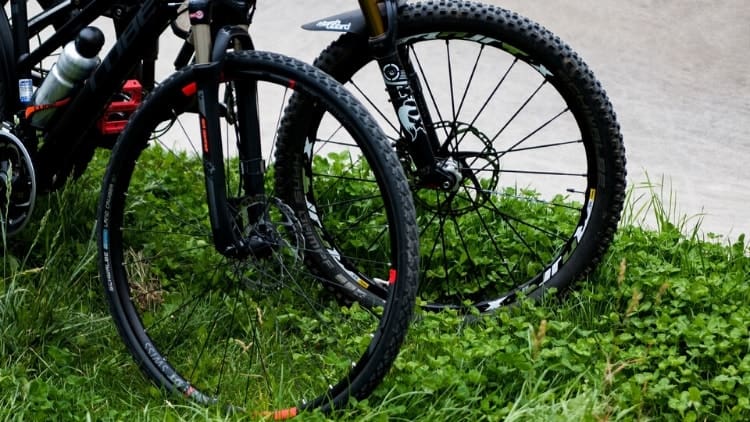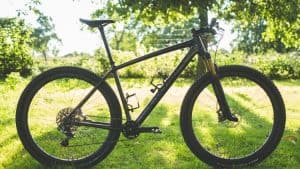There has been a lot of excitement in the industry lately with the introduction of innovative Mountain Bike technology.
On top of the cool components like Dropper Posts and Electric Mountain Bikes, there has also been a larger change in regard to Mountain Bike tire size.
The 26er that we’ve known since the 80s is now having to compete with the increasingly popular 27.5 and 29er.
And these two new wheel sizes offer a lot of appealing benefits over their smaller counterpart.
But with the two, seemingly great, options available, you may be struggling to decide which one is best for you.
In this article, we break down a few of the most common variables that you should keep in mind, as we directly compare the 27.5 to the 29er.
Similar to the 26er, 27.5-inch bikes aim to provide the handling and reliability of the smaller wheel sizes, while increasing their rollover ability and speed. 29ers prioritize momentum, stability, and attack angle, creating a faster and more comfortable ride over a longer distance, but also sacrificing agility and acceleration.
For a quick breakdown of the 27.5 vs 29er shootout, here is an at-a-glance look at some of the points we break down in this article. If you’re interested in how these tire sizes perform on their own, check out these articles on the other popular wheel sizes available; 29er Pros and Cons, 27.5 Pros and Cons, 26er Pros and Cons
What is 27.5er and 29er?

You may have already guessed by now, however, I will explain for those who are new to the terms.
A 27.5 refers to a Mountain bike with 27.5-inch wheels.
A 29er is a Mountain Bike with 29-inch wheels.
While you can have full suspension or Hardtail in either wheel size, most bikes are referred to by wheel size.
Comparing 27.5 and 29ers
1. Acceleration

Winner – 27.5
The benefits of a 27.5 are right in line with that of a 26er, with a few of the advantages of 29ers.
One of the first things to set the 27.5 and 29er apart, is Acceleration.
While the 27.5 aims to provide a solid middle ground between the two, critics would agree that the 27.5 takes more after the 26er than the 29er.
This smaller wheel size gives it the advantage over the 29er when it comes to getting the bike up and moving.
A 29er, a bike with heavier wheels, will require more energy and time to get up to speed.
The 27.5 on the other hand is only a fraction larger than the 26er, a bike that is regarded as the fastest and most nimble.
2. Maintaining Speed

Winner – 29er
While the fact that the 27.5 takes so much after the 26er usually makes it more appealing, it does come with a few drawbacks compared to the 29er.
Starting things off, the 29er is still going to be the best bike when it comes to maintaining speed.
While those extra few inches do help the 27.5er case, it cannot compete with the impressive inertia of a 29er.
The physics of the 29er wheel gives it a substantial advantage over the 27.5- and 26-inch wheel sizes.
The 29er uses a few of the points discussed in this article to maintain more speed, like attack angle, stability, and traction.
3. Traction

Winner – 29er
If you’re looking to maximize traction over slick rocks and techy rocks sections, the 29er is going to give you the most efficient traction.
Since the 29er wheel is larger in diameter, your Mountain Bike tires have a fraction more contact with the ground.
This comes in handy when you’re trying to brake on techy terrain, where your wheel is only in contact with the ground for short moments.
This is also a good benefit for those who hit those corners hard, as the additional grip will keep you more stable.
To be fair, the 27.5 has comparable traction, especially when you factor in the different tire sizes and pressures available for each one.
4. Attack Angle

Winner – 29er
The attack angle on a Mountain bike refers to the angles made between the axle of the bike wheel and the object that the rider intends to roll over.
In short, the shallower the angle, the easier it is for the bike to roll over that object.
Since 29ers are the largest diameter wheel on the market, they will always have the shallowest attack angle, and therefore, the upper hand when it comes to making it over objects.
Depending on the tire pressure you usually run, you may be hard-pressed to feel the difference on those smaller obstacles.
But on those rough and speedy descents and climbs, you are going to feel the stability and control a 29er offers.
27.5-inch tires do improve this angle over the 26er, but with them being so close, the improvement is not as significant as 29ers.
5. Weight

Winner – 27.5
As you have probably guessed, the 27.5 is going to almost always be the lighter choice between 27.5 and 29er.
Not only do they have less weight in the wheel, one of the heaviest components on a Mountain Bike, but the frame built around those wheels can accommodate a smaller profile.
On top of the large feeling of a 29er, a lot of riders opt for the 27.5 as it is still a manageable weight.
Not to say that the 29er is taxing to manage, in fact, you may find it to be quite comfortable to ride.
It’s just that the added weight can make the bike feel less responsive, requiring slightly more effort to through around on the trail.
6. Handling

Winner – 27.5
Again, the 27.5 was introduced to narrow the distance between the 26ers and 29ers.
What most riders find though, is that the 27.5 aligns more closely with the 26er.
With a shorter and lighter wheelbase than the 29er, the 27.5-inch bike is going to require less energy to move around.
And without the dampening effect some 29ers can have, you will also feel more in tune with how the bike and the trail are handling.
The bike geometry also comes into play here, further supporting the responsiveness of the 27.5.
7. Geometry

Winner – 27.5
In the shootout between the 26er and the 29er, the geometry debate was just about even.
Since they were both on two sides of the spectrum, the topic of fit and geometry was really left up to the riders’ choice.
However, since the 27.5 is often referred to as the “Goldilocks” of Mountain Bikes, I have to give it the win in this category.
Finding the balance between the smallest and largest Mountain Bikes on the market, the 27.5 really is a great fit for just about any rider.
Being only slightly larger than the 26er, with just as many frame options as the other, a 27.5 bike should not be counted out if you feel you’re too big or small.
8. Climbing

Winner – 29er
If you’ve ready any of my other shootouts or have had the opportunity to ride a 29er, you can already guess who wins this category.
The 29er is the ultimate climbing machine – at least in my eyes. Through those babies on a hardtail, you can climb for days.
I do have to give it to the 27.5, as the easier acceleration can help you climb faster, however, the 29er is going to get you up those bumpy hills in a lot better shape.
Especially if you can keep your momentum on the incline.
The weight of the 29-inch wheels will help your bike want to keep moving forward. Couple that with a consistent pedaling cadence and you’re climbing faster than before.
On top of that, the 29er is going to handle those rocks and bumps a lot better, keeping your energy focused on moving forward up the hill.
9. Strength

Winner – 27.5
While we used to see 26er dominating the discipline of Downhill Mountain Biking, we are starting to see more and more 27.5s at the trailhead.
Unlike the 29er, which has a relatively significant decrease in wheel strength, 27.5-inch wheels are still closer to the hub, with shorter spokes like the 26er.
This results in 27.5-inch wheels that are stronger than that of the standard 29er.
While this often doesn’t come too much into play for the average rider, performance athletes and those who really push their bikes to limit will notice.
10. Stability

Winner – 29er
While 27.5-inch wheels are stiffer and stronger than 29ers, that does not always translate over to stability.
In fact, 29ers are considered to be more stable than 27.5 bikes by a margin.
Not only do 29ers have more tire traction, keeping you grounded on the trail, but all that added weight also provides a few stabilizing benefits.
To start, extra weight helps 29-inch wheels want to stay straight and move in the same direction.
To jar a 29er off course, a bump or knock would have to be a little bigger than normal.
As well, the geometry of a 29er bike is designed so that the bottom bracket is better positioned between the wheel hubs.
This creates a more balanced riding position on the bike, helping you avoid those dreaded OTB crashes.
11. Availability

Winner – N/A
The only category on this list that is relatively matched for both 29ers and the 27.5, is the topic of availability.
Since they are both newer innovations to the industry, you can expect them to be equally as available on upgrades and parts.
What is a 29er Best for?
29ers are a solid and comfortable choice for most riders, but they definitely accel in some areas.
For one, they are exceptional climbers.
So, if you plan on riding a lot of XC-style trails with climbs and long stretches, the 29er will be your best option.
Actually, some would say the 29er is the best bike for XC.
What is a 27.5er Best for?
The 27.5 is built to be a great all-arounder and it really is true to purpose.
Offering the additional rolling ability while maintaining a similar geometry to the 26er allows 27.5 bikes to compete in areas like Downhill racing and Jump Parks.
This is also a solid option for any rider who is looking for a bike that can do it all.
Who Should Ride a 29er?
A 29er is a good bike for anyone who is looking for the most comfortable ride, especially if you prefer the feel of Hardtails.
The people who will really benefit from the 29er will be XC riders or people who feel like most other Mountain Bikes feel too small.
Who Should Ride a 27.5er?
Again, a 27.5 is good for a person who wants a bike that can virtually do it all.
With attractive options in full suspension and hardtails alike, you cannot go wrong.
If your alternative was a 29er, you may even find yourself saving some money in the long run.
Can a Short Person Ride a 29er?
Contrary to popular belief, shorter riders can definitely ride 29ers.
Although the wheelbase and bike geometry support a larger rider, there are frame sizes to fit just about any rider.
The best option is to visit your LBS for a fit or possibly some advice.
Chances are, they can help you pick the best option based on your criteria and needs.
Conclusion
In conclusion, the 27.5-inch bike is a solid option for those looking to upgrade from the old 26er or those who are looking for a good all-around Mountain Bike.
If you really prefer the benefits that the larger wheels bring or possibly need a larger-feeling bike, the 29er may just be the bike for you.
Good luck with deciding for yourself and safe riding!

